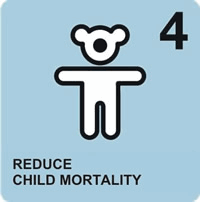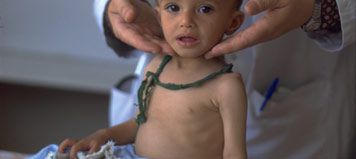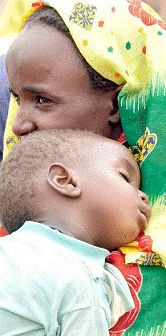| |
Millennium Goal 4 Reduce Child Mortality
Opening Prayer: Almighty and ever-living God, giver of life and love, and Sanctifier of all families: Protect the health and safety of all women in childbirth and the children whom they bear, and inspire your people to work for an end to the deadly conditions which fuel maternal and child mortality throughout the world; that, in building strong and healthy families and communities, all may be strengthened to do your will on earth until the day when you gather us into one heavenly family. We ask this through God our Creator, Jesus our Companion, and the Spirit our Guide. Amen.
Did you know?
The Millennium Project recommends that international donors should mobilize support for global scientific research and development to address special needs of the poor in areas of health, agriculture, natural resource and environmental management, energy, and climate. We estimate the total needs to rise to approximately $7 billion a year by 2015.
Target 1:
Reduce by two thirds, between 1990 and 2015, the under-five mortality rate.
QUICK FACTS:
> Worldwide, deaths of children under five years of age declined from 93 to 72 deaths per 1,000 live births between 1990 and 2006.
> A child born in a developing country is over 13 times more likely to die within the first five years of life than a child born in an industrialized country. Sub-Saharan Africa accounts for about half the deaths of children under five in the developing world.
> Between 1990 and 2006, about 27 countries – the large majority in sub-Saharan Africa – made no progress in reducing childhood deaths.
Imagine not being able to keep your child safe from easily treatable maladies, such as infections, diarrhea and measles.
Every year, almost 10.5 million children in developing countries die before the age of five.
Most die from causes that are readily preventable in rich countries: acutel respiratory infections, diarrhea, measles and malaria. While rapid improvements prior to 1990 gave much hope that mortality rates for infants and children under five would be cut, progress slowed during the 1990s. Progress has been slow, especially in Sub-Saharan Africa, where civil disturbances and the HIV/AIDS epidemic have actually seen a rise in infant and child mortality.
Suggestions for Enhancement of lessons:
See what you know about the global distribution of mortality caused by diarrhea, malaria, measles, pneumonia and neonatal issues. Go to the following link and do some further research. (http://www.unicef.org/mdg/mortalitymultimedia/index.html)
Read of a success story in combating measles
4 December 2008
The Eastern Mediterranean region achieves measles goal three years early
 (http://www.who.int/immunization/newsroom/emr_measles_goal_dec2008/en/index.html) (http://www.who.int/immunization/newsroom/emr_measles_goal_dec2008/en/index.html) An excellent source for further reading of the health issues facing most developed countries is Pathologies of Power: Health, Human Rights and the New War on the Poor by Paul Farmer, a Boston-based doctor who spends more than half of his time working for the improved health of the poor.
| ||||||




